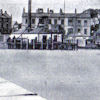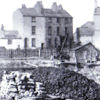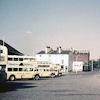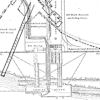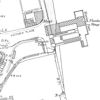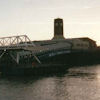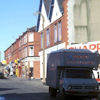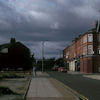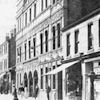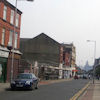Seacombe
'Seacombe' - Celtic or British "Cwm" - "Sea Hollow" or "The Hollow By The Sea".
There was no Manor House in Seacombe as the township was joined with Poulton, hence Poulton-cum-Seacombe, In 1545 it is recorded that there were 85 people living in the two villages. The population was 178 in 1801, 3044 in 1851, and 20749 in 1901. Seacombe, in those days was, no doubt, situated on the mouth of the Wallasey Pool rather than on the Mersey itself.
The township of Poulton-cum-Seacombe was amalgamated with the townships of Wallasey and Liscard in 1910 to form the Borough, later the County Borough of Wallasey.
The first mention of a ferry service in Seacombe was in 1515. In 1817 the owner of the ferry was Richard Smith and for many years he leased it to Thomas Parry who also ran Parry's Seacombe Hotel. The ferry passed through various hands until it was purchased by the local board in 1861.
By the 1870s the Ferries daily congestion, as passengers queued to board a steamer, made it clear that the ferry facilities were inadequate. In July 1876 work began on the redevelopment of the ferry. Four acres of land was reclaimed from the river. The new ferry building terminal, approach road, hydraulic lift for vehicular traffic, rebuilding of the Seacombe Ferry hotel and floating landing stage, which could accommodate a passenger steamer and a luggage boat, opened on the 5 January 1880 at a cost of £143,508. The landing stage for the ferry was a 314 foot by 82 foot floating stage. Four gangways were built and two bridges would lead to the Terminal pay boxes.
In February 1909 the S.S Ottaman rammed the landing stage, wrecking the north gang plank and some of the stage structure. Apart from repairing the landing stage and approaches the ferry remained unchanged until the 1920s.
In the 1920's and 1930's the ferry terminal buildings and the approaches were rebuilt and improved at a cost of £98,443. A new three lane floating roadway was built in 1925 and was opened by Lord Derby on the 23rd October 1926. The Seacombe Ferries terminal buildings and approaches officially opened on the 10th April 1933. In the 1960's the floating roadway was removed, The old landing stage was removed in 2000 and replaced with a new stage. In 2006 the Terminal went through a £500,000 redevelopment with an increase in car and sail parking spaces and a £10 million space-themed attraction called ‘Spaceport’.
St. Paul's Church was designed by John Hay of Liverpool. The foundation stone was laid down on the 6th June 1846 in the style of Early Middle Pointed of the 13th Century. It was consecrated on the 12th October 1847 and the Revered Edward Roberts, B. A, became the first vicar.
When the sandstone church was completed it had a spire of 120 feet but it was deemed as too dangerous so 20 feet was removed from the top. The church has been enlarged twice and currently holds about 650 people.
"Brighton Street Methodist Church"
The foundation stone of the church was laid down on 18th November 1858 by the Methodist Henry Pooley who resided at 'Homecroft' (now the Y.M.C.A on Manor Road). The church opened for worship on 1st September 1859. The church was the first public building to be lit by gas and was supplied by the Egremont Ferry Works.
Inside the church the ceiling was timbered and the organ was placed above the communion table, with pews for the choir. The pulpit was made of stone from Normandy, France.
Each Christmas Day a breakfast was provided for the needy. These were 600 in number, of whom 500 were children. The day started at 3 a.m., the work usually carried out by Sunday School staff. The first sitting was at 8 a.m. In 1905 it cost the church £25.
The church suffered damage during the Second World War resulting in the steeple being taken down in 1947.
In 1964 the church was demolished and a car park now occupies the area.
Concertina Cottages was a housing scheme designed and built by John Ellis in the 1870s. His vision of building an estate of houses came to fruition on land next to St. Joseph's Church in Wheatland Lane. Thirty-three properties in six blocks were erected from the planned ninety-two. They were hexagonal in shape, as the group radiated from a central chimney, and hence, became known as Concertina Cottages.
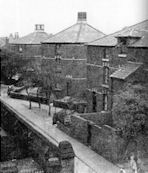 |
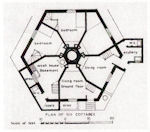 |
The Concertina Cottages survived until 1954 when they were all demolished. St. Joseph's Primary School now occupies the site.
'The Seacombe Ferry Hotel was built in the 1870's. It was a large four storey building that faced the ferry approach. It had twenty-five bedrooms with running hot and cold water and electric fires. The hotel also had a lift to all floors. The building was demolished in 1978 and a smaller licensed premises built in its place.
There was an older hotel on the site which was established when the ferry began in the 1800's and it was known as 'Parry's Seacombe Hotel'. It had a popular American bowling alley and a summer house. The hotel stood on elevated land with a sea wall running along the frontage.
On 4th August 2011, after a serious of local disturbances, the pub was demolished.
The Irving Theatre stood on Victoria Road (later renamed as Borough Road) and it took its name from the famous repertory actor, Sir Henry Irving (1838 - 1905), who laid the corner stone on 11th October 1899. It was understood that Sir Henry only allowed his name to be used on the condition that the theatre showed serious drama's. The theatre could hold 2,500 and opened on 18th December 1899 with 'The Sign Of The Cross'.
After a fire in 1908 the theatre reopened as 'The Kings', never to be called 'The Irving Theatre' again. In 1912 the theatre was renamed again as 'La Scala' under the new management of Ludwig Blatter. The theatre went through several improvements and in August 1918 was renamed as 'The Hippodrome' under the management of Fred Ross. In March 1923 the theatre was sold to A.J Moran and renamed 'The Casino' but after 6 months it had reverted back to 'The Hippodrome' with Will J. Prescott as the manager. For a short time the theatre was called 'The Irving Repertory Theatre".
In 1928 the theatre again was under new management and with the old name of 'The Hippodrome'. The theatre closed in 1930 and reopened in the same year with Fred Ross again as manager. Not long afterwards, the theatre closed and remained so for a while until Pat Collins purchased the theatre with Richard "Dick Batch" Batchelor as the manager and the theatre opened on 12th November 1934 with a young comedian actor Tommy Trinder appearing on stage
The Buxton Theatre Company took over the building in 1936 and opened it as the 'Embassy'. It remained as such until forced to close because of poor attendances on 31st March 1959 when it became a bingo hall.
